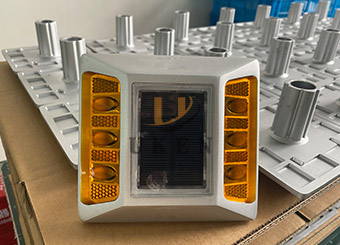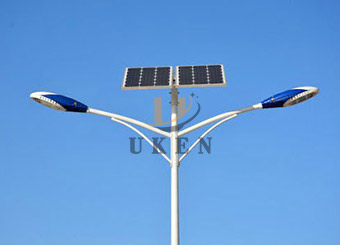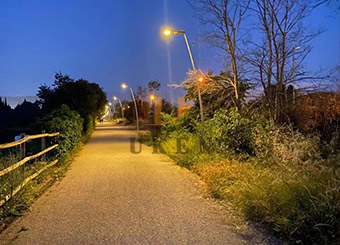In the booming development of intelligent transport and road safety in the spotlight, solar road studs in the field of road facilities occupy an increasingly critical position. With the road construction in full swing, whether it is the city’s main roads, or rural winding roads, the demand for traffic safety facilities are increasing day by day. Solar road studs with its unique advantages, become a popular choice to protect road safety, optimise traffic guidance, the market heat continues to climb.
Solar energy into electricity process
The energy source of solar road studs is solar energy, which relies on the magical photoelectric effect. Solar panel is the key component, which is usually made of semiconductor material. When sunlight hits the solar panel, the energy carried by the photons is absorbed by the semiconductor material. The photons interact with the atoms in the semiconductor, causing the electrons in the atoms to gain enough energy to break free from the nucleus and create electron-null pairs. Under the action of the electric field inside the semiconductor, these electrons and holes move in different directions, creating an electric current that successfully converts solar energy into electricity.
Electricity Storage and Lighting Mechanism
The converted electrical energy is not consumed immediately, but is stored in the battery. The battery acts as an ‘energy warehouse’, reserving energy for subsequent lighting. The controller comes into play when night falls, or when the surroundings are poorly lit. It acts as an intelligent housekeeper, precisely regulating the release of electrical energy from the battery. The electrical energy is transmitted through the circuit to the LED lamps, which are driven to emit light, and the bright light emitted by the LED lamps shoots out through the well-designed lampshade according to a specific angle, clearly illuminating the road outline, providing drivers with accurate road guidance and warnings, and safeguarding night-time driving safety.
Functions of each component
Solar Road Stud is composed of several important components. The solar panel, as an energy collector, is responsible for capturing the energy from sunlight and converting it into electricity, which is the energy source of the whole road stud; the LED light, which undertakes the important task of illumination and warning, emits high-brightness light, which is particularly eye-catching in the darkness, and helps drivers to identify the direction of the road. Batteries are used to store the electricity generated by the solar panels, ensuring that the stud can continue to work when there is no light. The controller precisely regulates the current and voltage to ensure the stable operation of each component, avoiding damage to the equipment due to unstable current and voltage. The sturdy shell not only protects the internal precision components, but also resists external mechanical shocks and harsh environmental erosion.
Synergistic Relationship of Components
The components work very closely with each other. The solar panels generate electricity, which is then transferred to the battery for storage. The power stored in the battery is not released randomly, but is steadily supplied to the LEDs under the strict control of the controller. The controller intelligently adjusts the output current and voltage according to the ambient light intensity, battery power and other factors, ensuring that the LED lights always work in the best condition. The sturdy shell protects the internal solar panels, batteries, controllers and LED lights from external factors such as vehicle crushing, rain immersion, sand erosion and other damages, to jointly ensure the stable operation of the solar studs, continue to play a role.
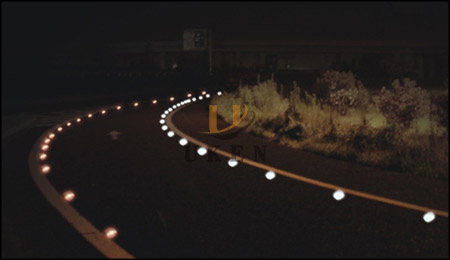
Brightness and visible distance
The lighting brightness of the solar road studs is very considerable, Under ideal weather conditions, such as a clear night, it can be seen from a distance of up to 200 metres. This means that drivers can clearly see the light emitted by the road studs from a distance and make a good judgement on road conditions in advance. Even in bad weather, such as light rain, the visual distance can be maintained at about 100 metres; in misty weather, the visual distance is about 50 metres. Compared with traditional road studs, the active light-emitting properties of solar road studs make them more visible in all kinds of environments, which greatly improves the visibility and safety of roads.
Lighting Duration
The illumination duration of solar road studs is closely related to the battery capacity and charging condition. When the battery is fully charged, under normal use, i.e. according to the calculation of 12 hours of work per day, it can maintain stable lighting for up to 72 hours. In areas with sufficient light, the solar panels only need about 4 hours to fully charge the battery. In areas with relatively poor lighting conditions, the charging time may extend to 8 hours. However, even under continuous cloudy conditions, the solar studs can still guarantee more than 48 hours of basic illumination to meet the road’s nighttime lighting needs, thanks to the highly efficient energy storage technology.
Anti-crushing and anti-impact ability
Solar road studs are designed to fully consider the crush and impact resistance. Its shell is usually made of high-strength engineering plastics or metal alloys, and the internal structure is also carefully reinforced. Take the common high-strength engineering plastics shell as an example, it can withstand up to 80 ton of pressure, that is to say, the general family car or even part of the light trucks will not cause substantial damage to its crushing. In terms of impact resistance, the Solar Road Studs can withstand multiple free-fall impact tests from a height of 200 metres without damage. This strong resistance to crushing and impact ensures that it can work stably for a long time on roads with frequent traffic.
Weather Resistance
Whether it is hot sun or cold wind, solar road studs can handle it with ease. In high-temperature environments, such as temperatures up to 80°C, the high-temperature-resistant material ensures that the internal circuits and batteries work properly, without performance degradation or failure due to overheating. In low-temperature environments, even at temperatures as low as -20℃, the specially designed battery and insulation structure can ensure the normal operation of the stud. In the face of wind, sun, rain, freezing and other harsh climate, the shell of the solar stud has good waterproof, dustproof and UV resistance. After long-term outdoor testing, in the continuous 7 days of rainstorms, the studs will not enter the water inside; after 128hours of ultraviolet radiation, the shell will not appear obvious aging, fading phenomenon, to ensure that the service life in a variety of complex climatic conditions and performance stability.

Highway application advantages
On the highway, the vehicle travelling speed, the driver of the road information acquisition requirements are extremely high. Solar road studs with its high brightness lighting and long visible distance, become a powerful assistant to protect the safety of the highway. It can clearly outline the road boundary, in the bend, in advance to provide drivers with accurate information on the direction of the bend. At night or in bad weather, its stable lighting effect allows drivers to be ready to respond at a distance, effectively reducing traffic accidents caused by poor visibility. For example, on a motorway at night, the bright light emitted by the solar road studs can be clearly seen from 200 metres away, providing sufficient reaction time for vehicles travelling at high speed.
Effectiveness on Urban Roads
In urban roads, solar road studs work together with traffic signals and markings to build a perfect traffic guidance system. It can remind drivers to pay attention to traffic rules and pedestrian safety through flashing or constant lights at key locations such as intersections and pedestrian crossings. In the district, campus and other areas, solar road studs provide soft lighting, not only to meet the needs of night travel, but also to avoid light pollution, creating a comfortable and safe night environment. For example, in the internal roads of the district, the light of solar road studs is moderately bright, which will not affect the residents’ rest, and at the same time, it can light up the road, which is convenient for the residents to walk at night and the vehicles to drive.
Rural and remote road role
For rural roads and remote areas, the independent power supply advantage of solar road studs is particularly prominent. These areas often have insufficient grid coverage or unstable power supply problems, and solar road studs do not need external power supply, relying on solar energy can work normally. It provides convenience for rural residents travelling at night, so that villagers returning home late can go home safely. In remote mountainous highways, the lighting and warning effect of solar road studs ensures the safety of passing vehicles and promotes the development of transport in remote areas.
Function in bad weather environment
In stormy weather, rainwater can cause serious interference to road lighting and signage. However, the waterproof design of the solar road stud makes its interior unaffected by rainwater, and at the same time, its special optical design can effectively penetrate the rain curtain and maintain a certain degree of visibility. In dense foggy weather, the light emitted from the solar road studs is specially processed to have strong penetrability, which can provide drivers with road guidance even in extremely low visibility. In snowy weather, the snow-resistant design of its shell can prevent snow cover and ensure that the light shoots out normally, continuing to play the role of lighting and warning.
Installation in complex terrain
In mountainous, hilly and other complex terrain areas, the installation of solar road studs needs to be adapted to the local conditions. Installers will adjust the installation angle of the stud according to the undulation and slope of the terrain to ensure that the solar panels can fully receive sunlight. At curved roads, road studs will be installed in an encrypted manner to enhance the warning effect of curved roads. For example, in the mountainous areas of the mountain road, by reasonably adjusting the installation angle and spacing of the solar road studs, so that it can be efficiently charged, but also for the driver to clearly indicate the winding direction of the road, to protect the safety of driving.
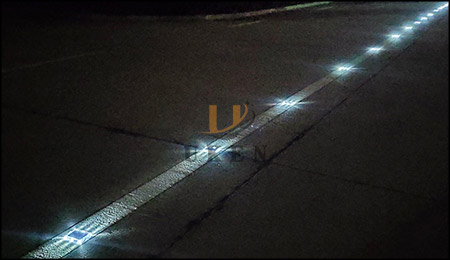
Preparation before installation
Before installing solar road studs, you need to make full preparation. For tools, prepare electric drills, screwdrivers, spanners and so on. The materials include solar road studs, fixing bolts, sealant and so on. Meanwhile, the survey of the installation site is crucial. The flatness of the ground should be checked to ensure that the dowels can stand firmly after installation. Light conditions should also be assessed to choose a location where the solar panels can receive sufficient sunlight. For example, avoid installations where there are tall trees or buildings that block the sunlight.
Detailed Installation Steps
When installing, first use an electric drill to make holes in the road surface, the depth and diameter of the holes should be determined according to the specifications of the stud and the ground material. Then put the base of the stud into the hole, use the fixing bolt to fix it firmly, pay attention to the bolt tightening strength should be moderate, to avoid too loose to cause the stud to loosen, or too tight to damage the road surface. Then connect the lines to ensure that the solar panels, batteries, LED lights and controllers between the lines are connected correctly and firmly, to avoid short circuits or circuit breakers. Finally, install the solar panel and LED lights, adjust the angle so that it can work properly, and use sealant to seal the interface to prevent rainwater infiltration.
Daily Maintenance
The daily maintenance of the Solar Stud is not complicated. Regularly check the surface of the solar panel for dust and stains, and if so, promptly wipe it with a clean soft cloth to ensure that the solar panel can fully absorb sunlight. Every once in a while, to test the battery power, through professional equipment to see whether the battery charging and discharging status is normal. At the same time, check the brightness of the LED lights, if you find that the brightness is weakened, it may be the aging of the LED lights or circuit problems, which need to be further investigated. Generally speaking, solar panel cleaning is carried out once a week, battery power test is carried out once a month, and LED light brightness check is carried out once a quarter.
Common Troubleshooting and Solutions
If the solar road studs do not light up, first check whether the solar panel is blocked and whether the wiring is loose or damaged. If the solar panel is normal and the wiring is not a problem, it may be a battery failure and need to replace the battery. When there is a problem of diminished brightness, it may be the aging of the LED light, at this time you can replace the LED light; it may also be the battery is not enough power, you need to check whether the charging system is normal. If you find charging abnormalities, such as the battery is not charged for a long time, to check whether the output voltage of the solar panel is normal, whether the controller is working properly, repair or replace the components for specific problems, to ensure that the solar road studs can return to normal operation.
Solar road studs play an indispensable role in enhancing road safety. Their efficient lighting effect, excellent durability, and ability to adapt to various complex environments all provide strong support for road safety upgrades. At the same time, its independent power supply, low maintenance costs, but also for the road construction and management has brought a lot of convenience. Here, we call on road construction and management stakeholders to actively consider the use of solar road studs, so that this excellent road safety facilities are widely used, contributing more power to road safety and protecting people’s travelling.

